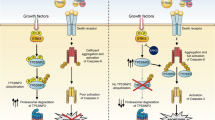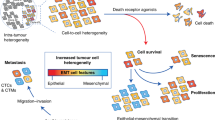Abstract
We previously reported that the anti-epidermal growth factor (EGF) receptor monoclonal antibody (mAb) 225 induces DiFi colon cancer cells to undergo apoptosis, and this apoptosis was accompanied by activation of the two apoptosis initiation caspases, caspase-8 and caspase-9. In the current study, we found that pretreatment of DiFi cells with the caspase-8-specific inhibitor z-IETD-fmk but not pretreatment with the caspase-9-specific inhibitor z-LEHD-fmk inhibited mAb 225-induced apoptosis, indicating that caspase-8 plays an essential role in initiating mAb 225-induced apoptosis. Because caspase-8 is activated primarily by the members of the tumor necrosis factor (TNF) receptor family, such as Fas, TNF receptor-1 (TNFR1), or receptors for TNF-related apoptosis-inducing ligand (TRAIL), we investigated whether mAb 225 activated caspase-8 by regulating one or more of these known pathways. Exposure of DiFi cells to TNFα or TRAIL activated caspase-8 and induced apoptosis in the cells. A TNFR1-antagonistic mAb or a TRAIL decoy receptor inhibited the activation of caspase-8 and the subsequent apoptosis induced by TNFα or TRAIL, respectively, in the cells. However, neither the TNFR1-antagonistic mAb nor the TRAIL decoy receptor inhibited mAb 225-induced activation of caspase-8 and apoptosis in DiFi cells. DiFi cells express detectable level of Fas but are not sensitive to the treatment by the Fas-agonistic mAb CH-11. A Fas-antagonistic mAb (ZB-4) inhibited the Fas-agonistic mAb CH-11-induced caspase-8 activation and apoptosis in Jurkat T-leukemic cells (used as positive control), but had no effect on mAb 225-induced activation of caspase-8 and apoptosis in DiFi cells. Taken together, our results suggest that mAb 225 does not interact with or regulate these known death receptor pathways. An exploration is therefore warranted for a novel mechanism by which mAb 225 activates caspase-8 and triggers apoptosis in DiFi cells.
This is a preview of subscription content, access via your institution
Access options
Subscribe to this journal
Receive 50 print issues and online access
$259.00 per year
only $5.18 per issue
Buy this article
- Purchase on Springer Link
- Instant access to full article PDF
Prices may be subject to local taxes which are calculated during checkout






Similar content being viewed by others
Abbreviations
- EGF:
-
epidermal growth factor
- TGFα:
-
transforming growth factor-α
- mAb:
-
monoclonal antibody
- caspase:
-
cysteinyl aspartate-specific proteinase
- TNFα:
-
tumor necrosis factor-α
- TRAIl:
-
TNF-related apoptosis inducing ligand
- TNFR1:
-
TNF receptor-1
- ELISA:
-
enzyme-linked immunosorbent assay
References
Adachi S, Cross AR, Babior BM, Gottlieb RA . 1997 J. Biol. Chem. 272: 21878–21882
Ashkenazi A, Dixit VM . 1998 Science 281: 1305–1308
Balachandran S, Roberts PC, Kipperman T, Bhalla KN, Compans RW, Archer DR, Barber GN . 2000 J. Virol. 74: 1513–1523
Bantel H, Engels IH, Voelter W, Schulze-Osthoff K, Wesselborg S . 1999 Cancer Res. 59: 2083–2090
Baselga J, Mendelsohn J, Kim YM, Pandiella A . 1996 J. Biol. Chem. 271: 3279–3284
Baselga J, Norton L, Masui H, Pandiella A, Coplan K, Miller Jr WH, Mendelsohn J . 1993 J. Natl. Cancer Inst. 85: 1327–1333
Baselga J, Pfister D, Cooper MR, Cohen R, Burtness B, Bos M, D'Andrea G, Seidman A, Norton L, Gunnett K, Falcey J, Anderson V, Waksal H, Mendelsohn J . 2000 J. Clin. Oncol. 18: 904–914
Belka C, Marini P, Lepple-Wienhues A, Budach W, Jekle A, Los M, Lang F, Schulze-Osthoff K, Gulbins E, Bamberg M . 1999 Oncogene 18: 4983–4992
Beltinger C, Fulda S, Kammertoens T, Meyer E, Uckert W, Debatin KM . 1999 Proc. Natl. Acad. Sci. USA 96: 8699–8704
Boldin MP, Goncharov TM, Goltsev YV, Wallach D . 1996 Cell 85: 803–815
Boldin MP, Varfolomeev EE, Pancer Z, Mett IL, Camonis JH, Wallach D . 1995 J. Biol. Chem. 270: 7795–7798
Bossy-Wetzel E, Green DR . 1999 J. Biol. Chem. 274: 17484–17490
Bossy-Wetzel E, Newmeyer DD, Gren DR . 1998 EMBO J. 17: 37–49
Chinnaiyan AM, O'Rourke K, Tewari M, Dixit VM . 1995 Cell 81: 505–512
Chinnaiyan AM, Tepper CG, Seldin MF, O'Rourke K, Kischkel FC, Hellbart S, Krammer PH, Peter ME, Dixit VM . 1996 J. Biol. Chem. 271: 4961–4965
Ciardiello F, Bianco R, Damiano V, De LS, Pepe S, De PS, Fan Z, Mendelsohn J, Bianco AR, Tortora G . 1999 Clin. Cancer Res. 5: 909–916
Enari M, Talanian RV, Wong WW, Nagata S . 1996 Nature 380: 723–726
Fan Z, Baselga J, Masui H, Mendelsohn J . 1993a Cancer Res. 53: 4637–4642
Fan Z, Lu Y, Wu X, Mendelsohn J . 1994 J. Biol. Chem. 269: 27595–27602
Fan Z, Masui H, Altas I, Mendelsohn J . 1993b Cancer Res. 53: 4322–4328
Fan Z, Mendelsohn J . 1998 Curr. Opin. Oncol. 10: 67–73
Fan Z, Shang BY, Lu Y, Chou JL, Mendelsohn J . 1997 Clin. Cancer Res. 3: 1943–1948
Fellenberg J, Mau H, Scheuerpflug C, Ewerbeck V, Debatin KM . 1997 Int. J. Cancer 72: 536–542
Gil J, Esteban M . 2000 Oncogene 19: 3665–3674
Green DR, Reed JC . 1998 Science 281: 1309–1312
Itoh N, Yonehara S, Ishii A, Yonehara M, Mizushima S, Sameshima M, Hase A, Seto Y, Nagata S . 1991 Cell 66: 233–243
Kawamoto T, Sato JD, Le A, Polikoff J, Sato GH, Mendelsohn J . 1983 Proc. Natl. Acad. Sci. USA 80: 1337–1341
Kharbanda S, Pandey P, Schofield L, Israels S, Roncinske R, Yoshida K, Bharti A, Yuan ZM, Saxena S, Weichselbaum R, Nalin C, Kufe D . 1997 Proc. Natl. Acad. Sci. USA 94: 6939–6942
Kim CN, Wang X, Huang Y, Ibrado AM, Liu L, Fang G, Bhalla K . 1997 Cancer Res. 57: 3115–3120
Kluck RM, Bossy-Wetzel E, Green DR, Newmeyer DD . 1997 Science 275: 1132–1136
Li H, Zhu H, Xu CJ, Yuan J . 1998 Cell 94: 491–501
Li Y, Kanki H, Hachiya T, Ohyama T, Irie S, Tang G, Mukai J, Sato T . 2000 Int. J. Cancer 87: 473–479
Liu B, Fang M, Lu Y, Mendelsohn J, Fan Z . 2001 Oncogene 20: 1913–1922
Liu B, Fang M, Schmidt M, Lu Y, Mendelsohn J, Fan Z . 2000 Br. J. Cancer 82: 1991–1999
Liu X, Kim CN, Yang J, Jemmerson R, Wang X . 1996 Cell 86: 147–157
Liu X, Zou H, Slaughter C, Wang X . 1997 Cell 89: 175–184
Mendelsohn J, Shin DM, Donato N, Khuri F, Radinsky R, Glisson BS, Shin HJ, Metz E, Pfister D, Perez-Soler R, Lawhorn K, Matsumoto T, Gunnett K, Falcey J, Waksal H, Hong WK . 1999 Proc. Am. Soc. Clin. Oncol. 18: 389a abstract 1502
Micheau O, Solary E, Hammann A, Dimanche-Boitrel MT . 1999b J. Biol. Chem. 274: 7987–7992
Micheau O, Solary E, Hammann A, Dimanche-Boitrel MT . 1999a J. Biol. Chem. 274: 7987–7992
Milas L, Mason K, Hunter N, Petersen S, Yamakawa M, Ang K, Mendelsohn J, Fan Z . 2000 Clin. Cancer Res. 6: 701–708
Muzio M, Chinnaiyan AM, Kischkel FC, O'Rourke K, Shevchenko A, Ni J, Scaffidi C, Bretz JD, Zhang M, Gentz R, Mann M, Krammer PH, Peter ME, Dixit VM . 1996 Cell 85: 817–827
Muzio M, Stockwell BR, Stennicke HR, Salvesen GS, Dixit VM . 1998 J. Biol. Chem. 273: 2926–2930
Nagata S . 1997 Cell 88: 355–365
Nicholson DW, Thornberry NA . 1997 Trends Biochem. Sci. 22: 299–306
Peng D, Fan Z, Lu Y, DeBlasio T, Scher H, Mendelsohn J . 1996 Cancer Res. 56: 3666–3669
Perez-Soler R, Shin d, Donato N, Radinsky R, Khuri F, Glisson BS, Shin H, Matsumoto T, Lawhorn K, Hong WK, Mendelsohn J . 1998 Proc. Am. Soc. Clin. Oncol. 17: 393a abstract 1514
Rytomaa M, Martins LM, Downward J . 1999 Curr. Biol. 9: 1043–1046
Sakahira H, Enari M, Nagata S . 1998 Nature 391: 96–99
Sato JD, Kawamoto T, Le AD, Mendelsohn J, Polikoff J, Sato GH . 1983 Mol. Biol. Med. 1: 511–529
Schlegel J, Peters I, Orrenius S, Miller DK, Thornberry NA, Yamin TT, Nicholson DW . 1996 J. Biol. Chem. 271: 1841–1844
Sheikh MS, Antinore MJ, Huang Y, Fornace AJ . 1998 Oncogene 17: 2555–2563
Smith CA, Farrah T, Goodwin RG . 1994 Cell 76: 959–962
Stampfer MR, Pan CH, Hosoda J, Bartholomew J, Mendelsohn J, Yaswen P . 1993 Exp. Cell Res. 208: 175–188
Stennicke HR, Jurgensmeier JM, Shin H, Deveraux Q, Wolf BB, Yang X, Zhou Q, Ellerby HM, Ellergy LM, Bredesen D, Green DR, Reed JC, Froelich CJ, Salvesen GS . 1998 J. Biol. Chem. 273: 27084–27090
Sun SY, Yue P, Zhou JY, Wang Y, Choi Kim HR, Lotan R, Sheng WG . 2001 Biochem. Biophys. Res. Commun. 280: 788–797
Sun XM, MacFarlane M, Zhuang J, Wolf BB, Green DR, Cohen GM . 1999 J. Biol. Chem. 274: 5053–5060
Thornberry NA, Bull HG, Calaycay JR, Chapman KT, Howard AD, Kostura MJ, Miller DK, Molineaux SM, Weidner JR, Aunins J . 1992 Nature 356: 768–774
Thornberry NA, Lazebnik Y . 1998 Science 281: 1312–1316
Ungefroren H, Voss M, Jansen M, Roeder C, Henne-Bruns D, Kremer B, Kalthoff H . 1998 Cancer Res. 58: 1741–1749
Van de Vijver MJ, Kumar R, Mendelsohn J . 1991 J. Biol. Chem. 266: 7503–7508
Wesselborg S, Engels IH, Rossmann E, Los M, Schulze-Osthoff K . 1999 Blood 93: 3053–3063
Wu X, Fan Z, Masui H, Rosen H, Mendelsohn J . 1995 J. Clin. Invest. 95: 1897–1905
Wu X, Rubin M, Fan Z, DeBlasio T, Soos T, Koff A, Mendelsohn J . 1996 Oncogene 12: 1397–1403
Yang X, Chang HY, Baltimore D . 1998 Mol. Cell 1: 319–325
Acknowledgements
The authors are grateful to Dr John Mendelsohn for support and encouragement of this study, to Dr Shi-Yong Sun of the Department of Head and Neck Oncology for many stimulating discussions, and to Mr Michael Worley of the Department of Scientific Publications for editorial assistance with the manuscript. This study was supported in part by the NCI cancer center core grant (CA16672), by a Bristol-Myers Squibb Research Award, and by a start-up fund to Z Fan by The University of Texas MD Anderson Cancer Center.
Author information
Authors and Affiliations
Rights and permissions
About this article
Cite this article
Liu, B., Fan, Z. The monoclonal antibody 225 activates caspase-8 and induces apoptosis through a tumor necrosis factor receptor family-independent pathway. Oncogene 20, 3726–3734 (2001). https://doi.org/10.1038/sj.onc.1204490
Received:
Revised:
Accepted:
Published:
Issue Date:
DOI: https://doi.org/10.1038/sj.onc.1204490
Keywords
This article is cited by
-
Acquired resistance to anti-EGFR mAb ICR62 in cancer cells is accompanied by an increased EGFR expression, HER-2/HER-3 signalling and sensitivity to pan HER blockers
British Journal of Cancer (2015)
-
Expression of growth factor receptors and targeting of EGFR in cholangiocarcinoma cell lines
BMC Cancer (2010)
-
Monoclonal antibody therapeutics and apoptosis
Oncogene (2003)



